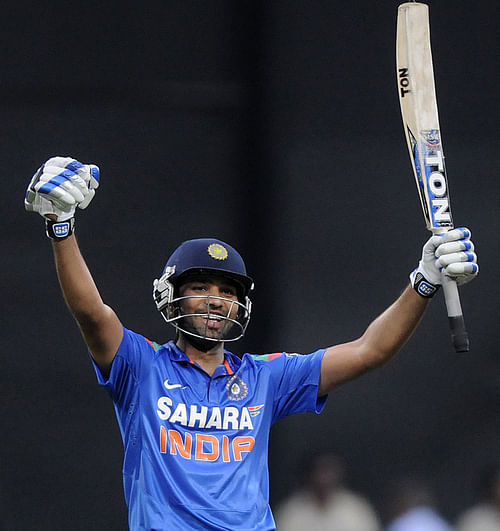
India vs Australia 2013: Alarming indications from the India-Australia Series

Rohit Sharma celebrates his double-century
Has the run-fest at Bangalore yesterday sunk in yet? Perhaps not. As it turned out, the final of a tightly contested series between #1 and #2 lived up to its billing. In the timeline of ODI cricket’s progress, this series will probably linger in the mind a bit longer than most other bilateral series. Not just the stats which were breached in the course, but the manner in which the proceedings unfolded have left this reverberating effect.
Some say it is natural progression, others believe it is killing the essence of cricket but the kind of records which have experienced modifications over the last few weeks renders you to ponder on these arguments a little deeper. 3 out of the 6 matches (all-time) with 700+ runs, 2ndand 3rd highest successful run-chases, fastest hundred by an Indian, fastest ton by an Australian, 3rd ODI double ton, most sixes in a 50-over match are excerpts of the phenomenal ‘batting’ achievements recorded over the last month.
Zoom in and the numbers keep startling. The average score in the series was 324/7, a boundary was hit (approximately) every 10thdelivery and on an average 10 sixes were hit in an innings! Further, in the 11 completed innings a side was dismissed completely only twice, 9 hundreds were scored and there were only 12 maiden overs in the 541.3 overs bowled in the 6 matches. It is the way you look at this numerical analysis but would be safe to say that only one facet of the game was contested fairly between the two sides.
A few onlookers were put-off by the frequency and ease at which the ball crossed the ropes, others felt that the evolution in the mentality and the new rules has yielded what the expectation was – exhaustive entertainment and some life for the 50-over format. To be fair the latter is a valid point of view, for very few bilateral series over the last 8-10 years have kept you engaged and enthralled like the one which just went by. Yes India and Australia are two very good ODI outfits, but it is the revolution of batsmanship in the coloured clothing which was the primary reason why each game of the 5 match series (barring the Pune ODI) was an evenly fought contest. On a graph, one data point cannot define a trend and would be better to the wait to find whether 300+ totals is the new norm in ODI cricket.
There is another side to this story. While big scores are simplistically ascribed to power hitting, those who follow the game closely will tell you that it is only a part of the attribution. It is not a mere coincidence that such a series has followed the implementation of the new rules – only 4 fielders outside the ring in the non-powerplay overs and the usage of 2 new balls. The fielding rule restriction is indeed a bit harsh on the bowlers. But going by the manner in which we witnessed six hitting in this series, guess we would have got almost the similar number of sixes with the old rule as well!
South Africa and Pakistan are competing in an ODI series in another part of the same continent. The disparity in the match summary sheets suggests that all ills are not from field restrictions. Often in cricket flatter the track or easier it is for batting tends to level the contest by diluting the necessity for utilizing skills. The effect of the two new ball rule was expected to negate reverse swing and make it harder for orthodox spin bowling, but as it has panned over this series it appears that the two new balls are acting as fodder big hitting. It wouldn’t be exaggeration to say that this rule is probably the killer for bowlers in the sub-continent. The softer ball in the second half of the innings previously ensured that the slog overs had its significance, but with the two new balls each of them is just 15 overs old once the innings enters the 31st over.
There was a six yesterday which came off Yuvraj’s thick edge while attempting an unconvincing hook. The flow of the bat and the pace of the delivered ball ensured that ball sailed just over the boundary ropes. Smaller grounds are ensuring that six hitting ability is more about power and confidence rather than timing and risk shot. The mindset is changing and we should be alive to this change. The bowling on either side in this series was not the greatest, in terms of lengths and innovation, but in the attempt to spruce up the game, one facet and its consequent legacy is taking a massive beating. Yes we need a few more series to draw inferences but primary indications are robust enough to merit concerns about the game becoming one dimensional!